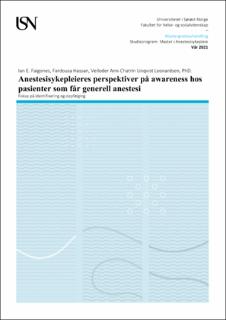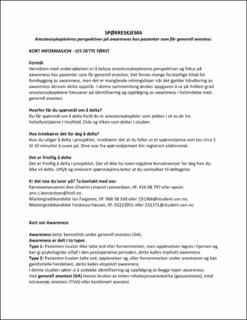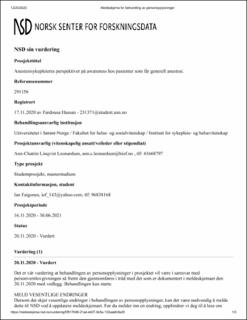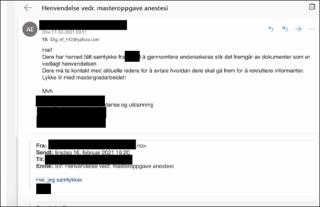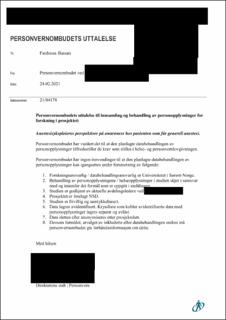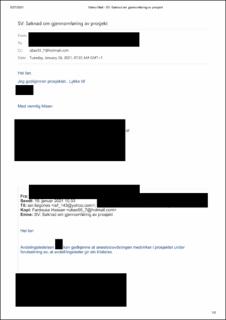| dc.contributor.advisor | Leonardsen, Ann-Chatrin Linqvist | |
| dc.contributor.author | Hassan, Fardousa | |
| dc.contributor.author | Faigones, Ian Esmediana | |
| dc.date.accessioned | 2021-11-23T17:41:43Z | |
| dc.date.available | 2021-11-23T17:41:43Z | |
| dc.date.issued | 2021 | |
| dc.identifier | no.usn:wiseflow:2539282:41724598 | |
| dc.identifier.uri | https://hdl.handle.net/11250/2831107 | |
| dc.description.abstract | Innledning: Awareness er en sjelden, men alvorlig komplikasjon av generell anestesi hvor pasienten er bevisst under kirurgisk inngrep og ikke kan uttrykke seg. Dette kan medføre noen psykologiske eller psykiske ettervirkninger som for eksempel post-traumatisk stresslidelse. Anestesisykepleiers hovedansvar under det peroperative forløpet er å gi tilstrekkelig anestesi og helhetlig omsorg i forbindelse med forebygging og håndtering av komplikasjoner. Det har vært veldig mye fokus på forebygging, men lite fokus på identifisering og oppfølging av denne komplikasjonen.
Mål: Hensikten med denne oppgaven var å belyse anestesisykepleiernes perspektiver på awareness hos pasienter som får generell anestesi, samt i hvilken grad anestesisykepleierne fokuserer på identifisering og oppfølging av awareness.
Metode: Studien benyttet en kvantitativ tilnærming med deskriptivt-tverrsnittsdesign som ble gjennomført ved bruk av et selvutviklet spørreskjema. Utvalget i denne studien var anestesisykepleiere som jobber ved tre ulike sykehus i Sørøst-Norge. Spørreskjemaundersøkelsen ble gjennomført elektronisk ved å sende spørreskjemaene via jobb e-post til respondentene.
Resultater: Undersøkelsesfunn viste at nesten alle (97 – 100 %) av anestesisykepleierne benyttet kliniske tegn, vitale målinger, og pasientens bevegelse fremfor de nyere anbefalinger som; monitorering av ende-tidal konsentrasjon av anestesigass sammenlignet med minimum alveolar konsentrasjon (87 – 89 %), elektroencefalogram – bispektral indeks (65 – 71 %), og train of four – post tetanic contraction (59 %) (dersom pasienten får muskelrelaksantia) for overvåking av anestesidybden, og for å identifisere mistanke om awareness hos pasienter som får generell anestesi. Videre viste undersøkelsen at kun 8,6 % av anestesisykepleierne kjente til BRICE skjema til tross for at dette er gullstandard for observasjon av potensielle awareness hendelser.
Konklusjon: Anestesisykepleierne har stort fokus på å håndtere og betrygge pasienten ved mistanke om awareness peroperativt, men de har mindre fokus på identifisering og oppfølging av pasienten som kan ha opplevd awareness grunnet manglende retningslinjer eller prosedyrer på hvordan man skal håndtere hendelsen post-operativt. | |
| dc.description.abstract | Introduction: Awareness is a rare but serious complication of general anesthesia where the patient is conscious during surgery and cannot express himself / herself. This can lead to some psychological repercussions such as post-traumatic stress disorder. The nurse anesthetist’s main responsibility during the perioperative phase is to provide adequate anesthesia and comprehensive nursing care with regards to the prevention and management of complications. There has been a lot of focus on prevention, but there was little focus on identification and follow-up of this complication.
Goal: The purpose of this study was to shed light on the nurse anesthetists’ perspectives and focus on awareness in patients receiving general anesthesia, as well as the extent of their focus on identification and follow-up of awareness in connection with general anesthesia.
Methodology: The study used a quantitative approach with a descriptive cross-sectional design that was conducted using a self-prepared questionnaire. The sample in this study were nurse anesthetists who work at three different hospitals in south-eastern Norway that perform general anesthesia. The survey was conducted electronically by sending questionnaires to the respondents through their work e-mail addresses.
Results: Findings of the study showed that almost all (97 – 100 %) of the nurse anesthetists used clinical signs, vital signs, and patient's movement to monitor the depth of anesthesia and identification of awareness in patients receiving general anesthesia rather than the recent recommendations such as; monitoring of end-tidal concentration of anesthetic gas in comparison with the desired minimum alveolar concentration (87 – 89 %), electroencephalogram - bispectral index (65 – 71 %), and train of four - post tetanic contraction (59 %) (if the patient receives muscle relaxants). Furthermore, the study showed that only 8.6 % of the nurse anesthetists were familiar with BRICE questionnaire even though this is the gold standard for observation of a potential awareness complication.
Conclusion: The nurse anesthetists have more focus on handling and reassuring the patient suspected to have awareness perioperatively, but they have less focus on identifying and following up the patient who may have experienced awareness due to lack of guidelines or procedures on how to handle the complication post-operatively. | |
| dc.language | nob | |
| dc.publisher | University of South-Eastern Norway | |
| dc.title | Anestesisykepleieres perspektiver på awareness hos pasienter som får generell anestesi - Fokus på identifisering og oppfølging | |
| dc.type | Master thesis | |
